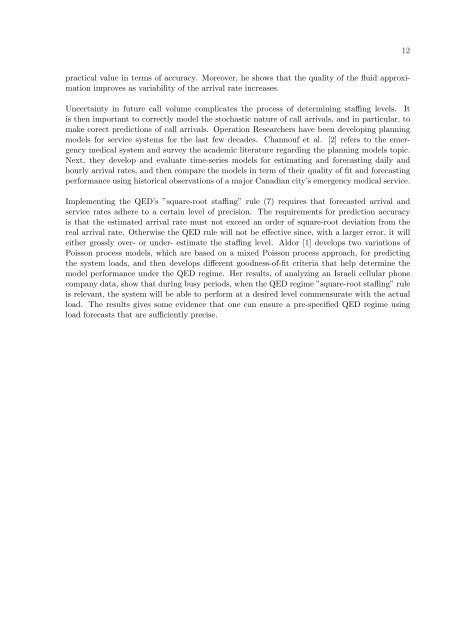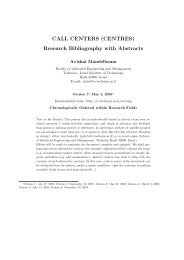Uncertainty in the Demand for Service - Faculty of Industrial ...
Uncertainty in the Demand for Service - Faculty of Industrial ...
Uncertainty in the Demand for Service - Faculty of Industrial ...
You also want an ePaper? Increase the reach of your titles
YUMPU automatically turns print PDFs into web optimized ePapers that Google loves.
practical value <strong>in</strong> terms <strong>of</strong> accuracy. Moreover, he shows that <strong>the</strong> quality <strong>of</strong> <strong>the</strong> fluid approximation<br />
improves as variability <strong>of</strong> <strong>the</strong> arrival rate <strong>in</strong>creases.<br />
<strong>Uncerta<strong>in</strong>ty</strong> <strong>in</strong> future call volume complicates <strong>the</strong> process <strong>of</strong> determ<strong>in</strong><strong>in</strong>g staff<strong>in</strong>g levels. It<br />
is <strong>the</strong>n important to correctly model <strong>the</strong> stochastic nature <strong>of</strong> call arrivals, and <strong>in</strong> particular, to<br />
make corect predictions <strong>of</strong> call arrivals. Operation Researchers have been develop<strong>in</strong>g plann<strong>in</strong>g<br />
models <strong>for</strong> service systems <strong>for</strong> <strong>the</strong> last few decades. Channouf et al. [2] refers to <strong>the</strong> emergency<br />
medical system and survey <strong>the</strong> academic literature regard<strong>in</strong>g <strong>the</strong> plann<strong>in</strong>g models topic.<br />
Next, <strong>the</strong>y develop and evaluate time-series models <strong>for</strong> estimat<strong>in</strong>g and <strong>for</strong>ecast<strong>in</strong>g daily and<br />
hourly arrival rates, and <strong>the</strong>n compare <strong>the</strong> models <strong>in</strong> term <strong>of</strong> <strong>the</strong>ir quality <strong>of</strong> fit and <strong>for</strong>ecast<strong>in</strong>g<br />
per<strong>for</strong>mance us<strong>in</strong>g historical observations <strong>of</strong> a major Canadian city’s emergency medical service.<br />
Implement<strong>in</strong>g <strong>the</strong> QED’s ”square-root staff<strong>in</strong>g” rule (7) requires that <strong>for</strong>ecasted arrival and<br />
service rates adhere to a certa<strong>in</strong> level <strong>of</strong> precision. The requirements <strong>for</strong> prediction accuracy<br />
is that <strong>the</strong> estimated arrival rate must not exceed an order <strong>of</strong> square-root deviation from <strong>the</strong><br />
real arrival rate. O<strong>the</strong>rwise <strong>the</strong> QED rule will not be effective s<strong>in</strong>ce, with a larger error, it will<br />
ei<strong>the</strong>r grossly over- or under- estimate <strong>the</strong> staff<strong>in</strong>g level. Aldor [1] develops two variations <strong>of</strong><br />
Poisson process models, which are based on a mixed Poisson process approach, <strong>for</strong> predict<strong>in</strong>g<br />
<strong>the</strong> system loads, and <strong>the</strong>n develops different goodness-<strong>of</strong>-fit criteria that help determ<strong>in</strong>e <strong>the</strong><br />
model per<strong>for</strong>mance under <strong>the</strong> QED regime. Her results, <strong>of</strong> analyz<strong>in</strong>g an Israeli cellular phone<br />
company data, show that dur<strong>in</strong>g busy periods, when <strong>the</strong> QED regime ”square-root staff<strong>in</strong>g” rule<br />
is relevant, <strong>the</strong> system will be able to per<strong>for</strong>m at a desired level commensurate with <strong>the</strong> actual<br />
load. The results gives some evidence that one can ensure a pre-specified QED regime us<strong>in</strong>g<br />
load <strong>for</strong>ecasts that are sufficiently precise.<br />
12
















